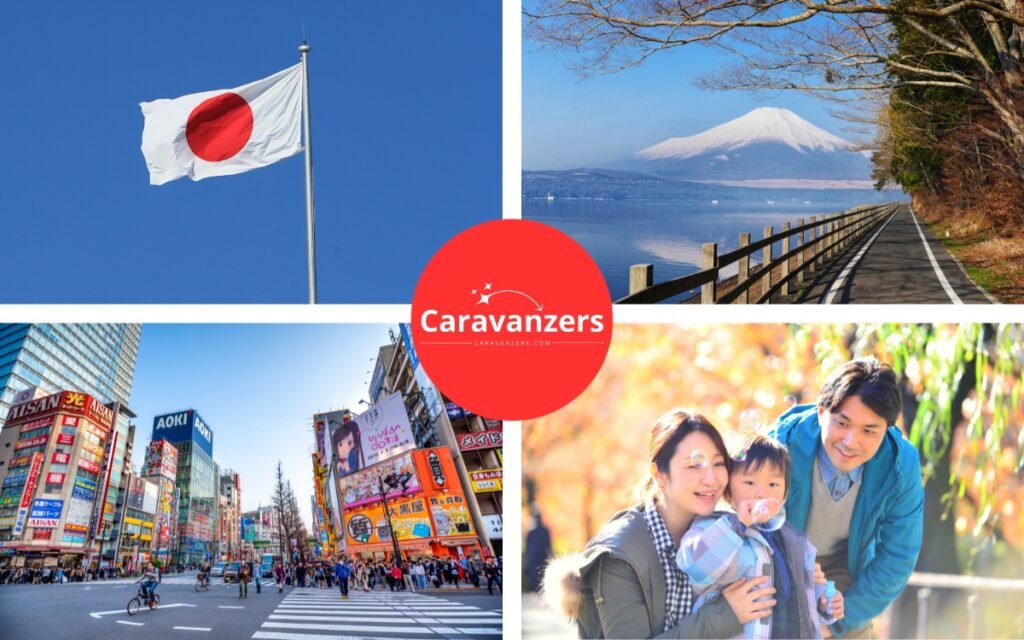
Japan travel tips. This guide will be helpful to your trip because it has everything you need to plan a memorable time.
This is one of the most popular countries in the world because a visit to Japan means you will immerse yourself in lively cities like Tokyo, experience serene landscapes, and indulge in yummy cuisine.
In this guide, I will share tips on historic temples, how to soak in hot springs, and witness the unique harmony of traditional and futuristic elements that define this culturally rich and diverse nation.
So, if you’re planning to visit Japan, here is a useful guide for you.
Japan Travel Basics

Japan is a captivating blend of ancient traditions and modern marvels. Unfortunately, though, it can’t accommodate all those who want to visit.
As a result, Americans, Europeans, Canadians, and Australians need a valid passport to enter Japan for short stays.
Americans, Europeans, Canadians, and Australians can stay for up to 90 days without a visa.
Extensions are possible for certain circumstances.
In terms of how to get there, Tokyo’s Narita International Airport and Haneda Airport are major hubs.
Likewise, Osaka’s Kansai International Airport, and Itami Airport, along with Chubu Centrair International Airport in Nagoya, are prominent.
Japan’s official currency is the Japanese Yen (JPY). This is widely used for transactions, and currency exchange services are available at airports, banks, and hotels.
Meanwhile, Japan has efficient and punctual transportation. High-speed Shinkansen trains connect major cities.
Also, extensive metro systems, buses, and well-maintained roads offer convenient options for local travel.
Finally, like the countries in this part of the world, Japan experiences diverse climates.
Summers are humid and warm, while winters vary from mild to cold with snowfall.
Cherry blossoms bloom in spring, and autumn usually comes with pleasant temperatures.
More Japan travel tips to follow.
When to Go
Japan’s best times to visit depend on your preferences. Spring (March to May) is popular for cherry blossoms.
So, spring creates a picturesque landscape, and a lot of travelers, especially Asians, love to come to Japan during this period.
For cherry blossoms, late March to early April is ideal, with locations like Tokyo and Kyoto offering prime viewing.
On the other hand, summer (June to August) brings lively festivals, though it can be hot and humid.
Summer festivals, like Gion Matsuri in Kyoto and Nebuta Matsuri in Aomori, occur in July and August.
Autumn (September to November) has stunning foliage, and winter (December to February) appeals to those seeking snow-covered landscapes and winter sports, particularly in regions like Hokkaido.
Autumn foliage peaks in November, with Kyoto and Nikko being popular destinations.
If you plan to ski or experience winter festivals, December to February is suitable, especially in places like Niseko and Sapporo.
Meanwhile, I really think you should consider avoiding the Golden Week in late April to early May, when travel demand is high, or the rainy season in June.
Finally, keep in mind regional variations and use these Japan travel tips to plan accordingly based on your interests and the experiences you seek.
Packing List for Japan

As you plan your packing, consider the seasons. Pack lightweight clothing for the mild temperatures of spring.
Include a light jacket or sweater for cooler evenings, as well as comfortable walking shoes that are essential for exploring cherry blossoms and cultural sites.
Don’t forget an umbrella and raincoat, as occasional showers are common, and make sure you have the appropriate electrical adapter for Japanese outlets.
Meanwhile, opt for lightweight and breathable clothing to stay cool in the summer heat.
Bring sunscreen, a hat, and sunglasses for UV protection, as well as insect repellent, which can be handy.
Also, consider a portable fan or cooling towel for extra comfort, and pack rain gear, as occasional downpours may occur during the rainy season.
The fall season is interesting in Japan. Prepare for fluctuating temperatures with layered clothing.
A jacket or sweater is great for cooler days, comfortable walking shoes are still important for exploring fall foliage, and bring an umbrella in case of rain.
Of course, no matter what season you’re visiting, make sure to bring an electrical adapter for Japanese outlets.
Finally, in Japan, you may not find widespread western-sized clothing, and shoe sizes may differ.
Additionally, some Western foods and products may be limited, especially snacks.
So, don’t overpack, but bring the things you will need.
Destinations in Japan
Japan travel tips without destinations would not be nice since this country presents a lot of them.
First of all, Tokyo is a bustling metropolis that has futuristic technology and traditional temples.
Mount Fuji, an iconic volcano, is a must-see, and it isn’t too far from Tokyo.
Also, Kyoto’s historic charm is home to ancient temples, gardens, and geisha culture.
Osaka combines modern attractions with a vibrant food scene, Hiroshima’s Peace Memorial Park reflects on history, and Hokkaido’s Niseko attracts winter sports enthusiasts.
Meanwhile, Okinawa’s tropical islands have beautiful beaches, Kanazawa is home to well-preserved Edo-era districts, and Nara has friendly deer and historic temples.
Of course, Takayama, surrounded by mountains, has a lot of traditional architecture.
So, each destination provides a unique blend of history, nature, and contemporary experiences.
Budget Travel in Japan
Unfortunately, Japan is very expensive, but you can still be on a budget with these ideas.
First of all, travel during shoulder seasons for lower accommodation rates and fewer crowds.
Regardless of when you are here, opt for budget accommodations like hostels, guesthouses, or budget-friendly hotels.
Take advantage of Japan’s efficient and affordable public transportation, such as buses and regional passes, and consider a Japan Rail Pass for cost-effective travel between cities.
Likewise, save on food by trying local street vendors, convenience store meals, and affordable local eateries known as “izakayas.”
Similarly, visit free attractions like parks, shrines, and public markets, and plan to go to festivals or events for cultural experiences without extra costs.
Meanwhile, use discount cards for museums, attractions, and public transportation, and consider local buses instead of taxis for short distances.
Also, embrace the convenience of 100-yen shops for budget-friendly souvenirs and engage in outdoor activities like hiking and exploring nature, which can be cost-effective and scenic.
Finally, shop in local markets for fresh produce and snacks and enjoy the charm of budget-friendly experiences that highlight the richness of Japanese culture.
What to Eat in Japan

A trip to Japan is nothing without the delicious food. So, I encourage you to savor the diverse cuisine that reflects the country’s culture.
Start your day with a traditional Japanese breakfast featuring grilled fish, miso soup, rice, and pickles.
For lunch, try the variety of bento boxes available at train stations or enjoy ramen, udon, or soba noodles.
Also, try tempura, a historic dish of battered and deep-fried seafood or vegetables.
And, of course, you don’t want to miss out on sushi and sashimi, featuring fresh, high-quality raw fish.
In the evenings, visit izakayas, Japanese pubs, where you can enjoy a range of small, flavorful dishes paired with sake or local beers.
Likewise, indulge in yakitori, skewered and grilled chicken, or okonomiyaki, a savory pancake filled with ingredients like cabbage, pork, and seafood.
Similarly, venture into street markets for snacks like takoyaki (octopus balls) and taiyaki (fish-shaped pastry filled with sweet fillings).
For dessert, try matcha-flavored treats like mochi or soft-serve ice cream.
Finally, embrace the local food culture and enjoy seasonal specialties, such as cherry blossoms during spring or hot pot dishes in winter.
So, Japan travel tips for food is plentiful, but we will have to stop here since, with an open palate, this is a great gastronomic adventure.
2-Week Japan Itinerary
The following Japan travel tips are based on a two-week visit. So, in two weeks, you can create a well-rounded itinerary covering Tokyo, Mount Fuji, Kyoto, and Nara.
Start your trip in Tokyo, visiting its colorful neighborhoods, iconic landmarks like Shibuya Crossing, and cultural sites such as Senso-ji Temple.
After a few days, use the efficient public transportation system, including the JR Pass, to reach Mount Fuji.
Spend a day or two in the Fuji Five Lakes region, enjoying views, hot springs, and outdoor activities.
From there, take the Shinkansen to Kyoto. Allocate several days to immerse yourself in Kyoto’s unique history, visiting UNESCO World Heritage sites like Kinkaku-ji and Fushimi Inari Shrine.
Also, go to a traditional tea ceremony and stroll through atmospheric districts like Gion.
Next, head to Nara for a day trip to see the friendly deer in Nara Park and visit historic temples like Todai-ji.
Return to Tokyo for the remaining days, ensuring you explore areas you may have missed initially.
Don’t forget to experience Tokyo’s modern side in districts like Akihabara and Odaiba.
So, this itinerary balances culture, nature, and modern city life, giving you the chance to savor the diverse facets of Japan within a two-week timeframe.
Basic Japanese Phrases
Japan is a fun country, but unfortunately, a lot of people don’t learn foreign languages.
So, if you have time, learn these before coming.
こんにちは (Konnichiwa) – Hello.
ありがとう (Arigatou) – Thank you.
いいえ (Iie) – No.
はい (Hai) – Yes.
お願いします (Onegaishimasu) – Please.
すみません (Sumimasen) – Excuse me / I’m sorry.
おはようございます (Ohayou gozaimasu) – Good morning.
こんばんは (Konbanwa) – Good evening.
いくらですか (Ikura desu ka) – How much is it?
どこですか? (Doko desu ka) – Where is it?
Final Thoughts
You had a ton of Japan travel tips with this guide, which is designed to assist you in planning your trip.
For instance, you went through lively cities such as Tokyo, savored the tranquility of scenic landscapes, and tasted in yummy cuisine.
You also got insights on visiting historic temples, enjoying rejuvenating hot springs and witnessing the unique blend of traditional and futuristic elements that characterize Japan.
So, if a visit to Japan is on your agenda, this guide is a valuable resource for your travel preparations.
Please let me know if you need help with anything, and, of course, enjoy your trip to Japan!
Yuri Takahashi writes about Japan for Caravanzers.
Follow us on Pinterest.
